The truckage manufacture has long been the backbone of worldwide ply chains, ensuring the smoothen channel of goods across cities, regions, and nations. As economies have mature and international trade expanded, the demand for DocuDrive ELD services has surged, qualification it a essential part of mundane life. However, in Holocene epoch eld, the manufacture has visaged many challenges that are reshaping its future. These challenges span restrictive changes, rise operational , shortages, and the profit-maximizing push toward sustainability. Despite these difficulties, the trucking industry has also seen substantial subject field advancements and innovation, paving the way for a more efficient, machine-controlled, and environmentally-conscious future.
One of the primary feather challenges facing the trucking manufacture is the current shortage of drivers. The American Trucking Association(ATA) has rumored that the trucking industry faces a shortfall of over 60,000 drivers, a total that is expected to grow in the coming years. This shortage is exacerbated by the ripening me, with many motortruck drivers nearing retreat age and few junior workers entrance the professing. This lack of drivers not only impacts the of the ply chain but also increases operating as companies vie for a express pool of eligible individuals.
Regulatory pressures are another significant touch for the trucking industry. Governments intercontinental are implementing stricter state of affairs standards to curb carbon emissions and combat mood transfer. The European Union, for example, has set enterprising targets to tighten the carbon step of the transportation sector, including the truckage manufacture. Similarly, in the U.S., the Environmental Protection Agency(EPA) has been tightening emissions standards, prompting truckage companies to invest in more fuel-efficient or electric vehicles. While these regulations are necessity for situation sustainability, they also add fiscal strain on companies, particularly moderate and medium-sized truckage firms.
The rising cost of fuel has also been a major challenge for trucking companies, as diesel motor prices vacillate and bear on the overall cost of doing business. Fuel is typically the largest operational for truckage companies, and any step-up in fuel prices can eat into turn a profit margins. Many companies are exploring option fuel sources, such as natural gas or electric automobile vehicles, as a way to mitigate these . However, these alternatives come with their own set of challenges, including high direct costs and the need for specialised infrastructure to subscribe these vehicles.
On the branch of knowledge front, the hauling manufacture has seen remarkable advancements that are both efficiency and refuge. The presentation of telematics and GPS tracking systems has allowed fleet operators to ride herd on routes, optimise fuel expenditure, and insure better deliverance timelines. Moreover, the rise of independent vehicles and the integrating of AI-powered systems promise to further revolutionize the industry by potentially reducing the need for homo drivers and lowering operational . Companies like Tesla, Waymo, and other startups are working on self-driving trucks that could be deployed in the orgasm years, although regulative hurdles and branch of knowledge limitations still stay.
Electric trucks are also becoming more prevailing in the industry, with major players such as Volvo, Daimler, and Rivian making strides in the of electric car heavily-duty trucks. These vehicles volunteer the forebode of turn down operational costs, reduced emissions, and less trust on fogy fuels. However, the borrowing of electric car trucks is still in its early on stages, and widespread execution will require significant investment in charging substructure and field of study advancements to insure these vehicles can wield long-distance hauls.
As the truckage manufacture adapts to these challenges, it also faces new opportunities for growth. The expanding upon of e-commerce has created a tide in demand for freight rate and logistics services, particularly in the last-mile saving segment. This swerve is push companies to introduce further, with the adoption of drones, robotics, and AI to ameliorate deliverance and meet expectations for faster service.
In termination, the truckage industry is at a polar minute, reconciliation between long-suffering challenges and embrace new technologies and innovations. While the road ahead may be fraught with obstacles, the opportunities for growth and shift are equally considerable. By investing in technology, sustainability, and me development, the manufacture can voyage these changes and continue to suffice as a crucial mainstay of the global economy for age to come.

